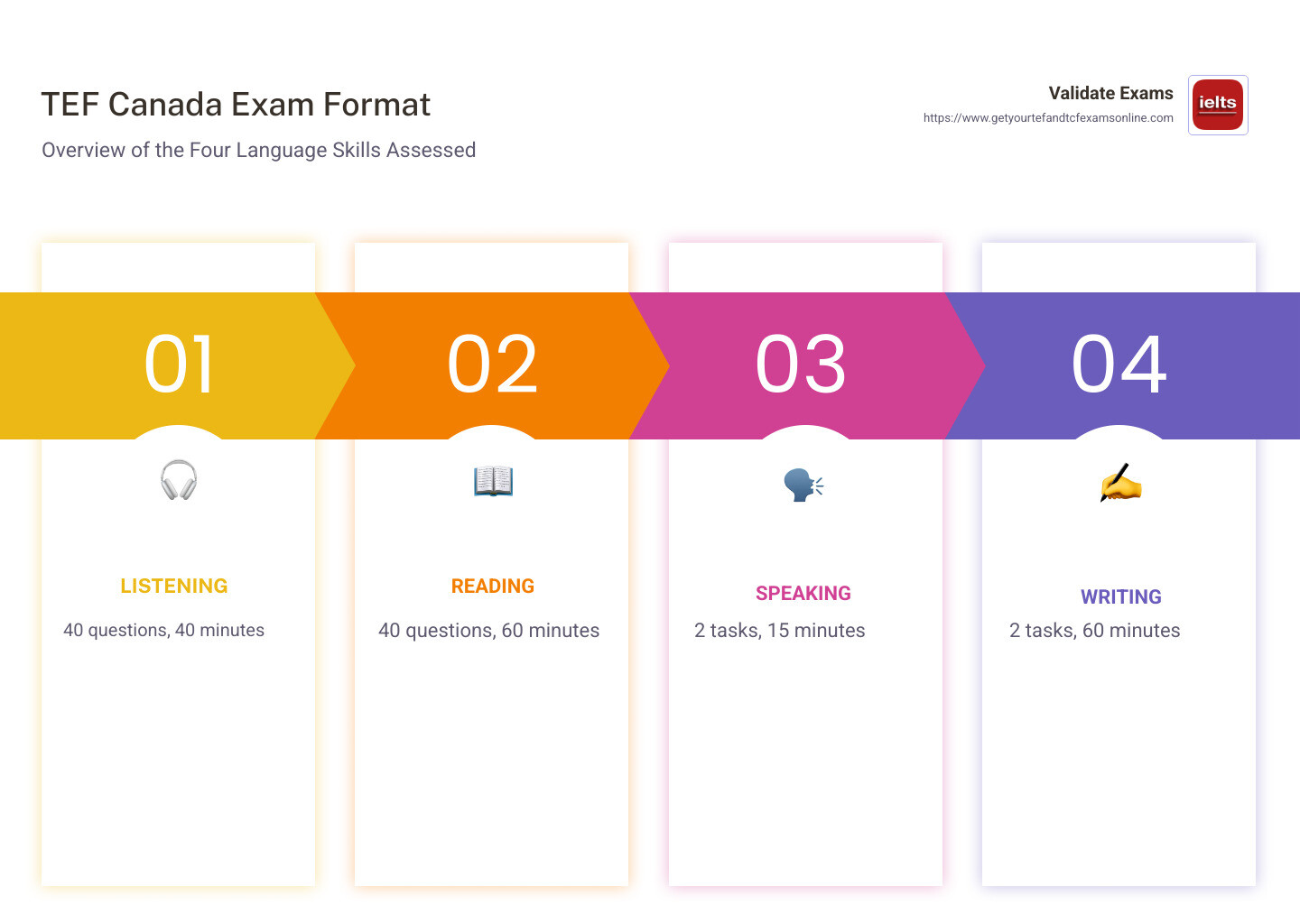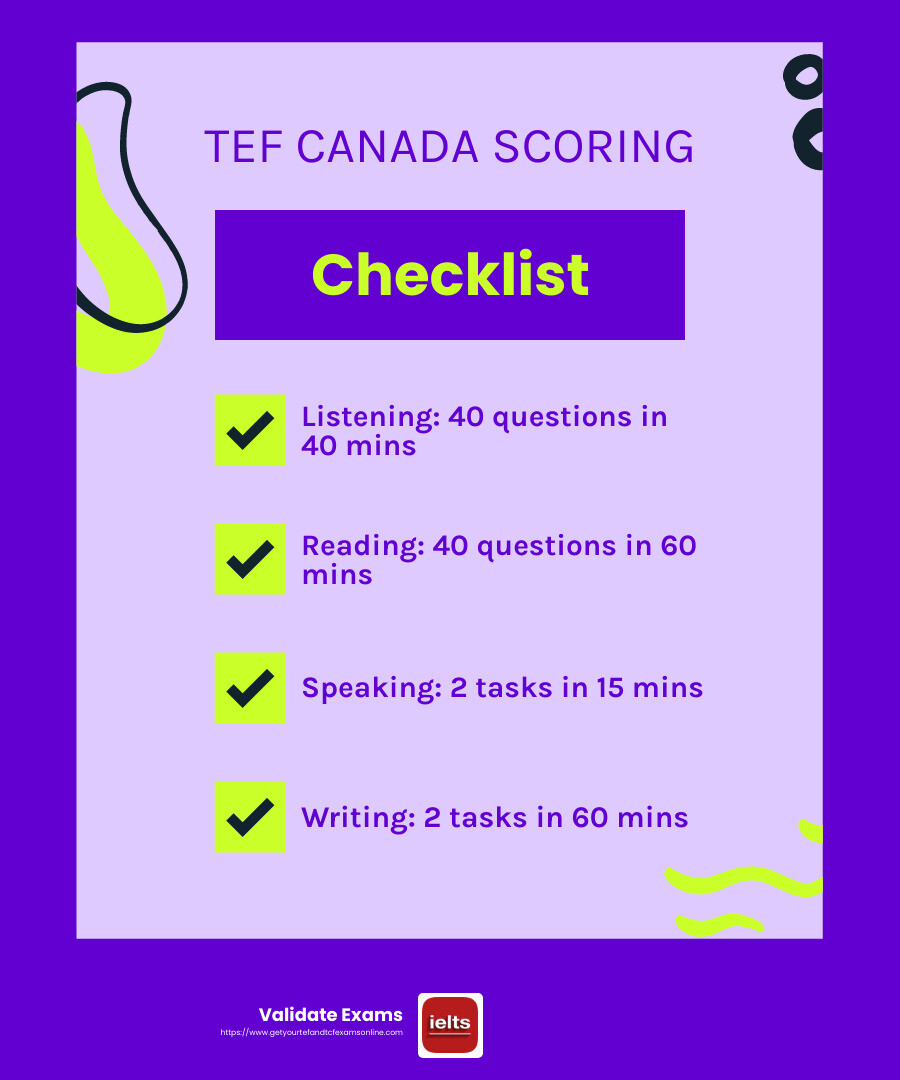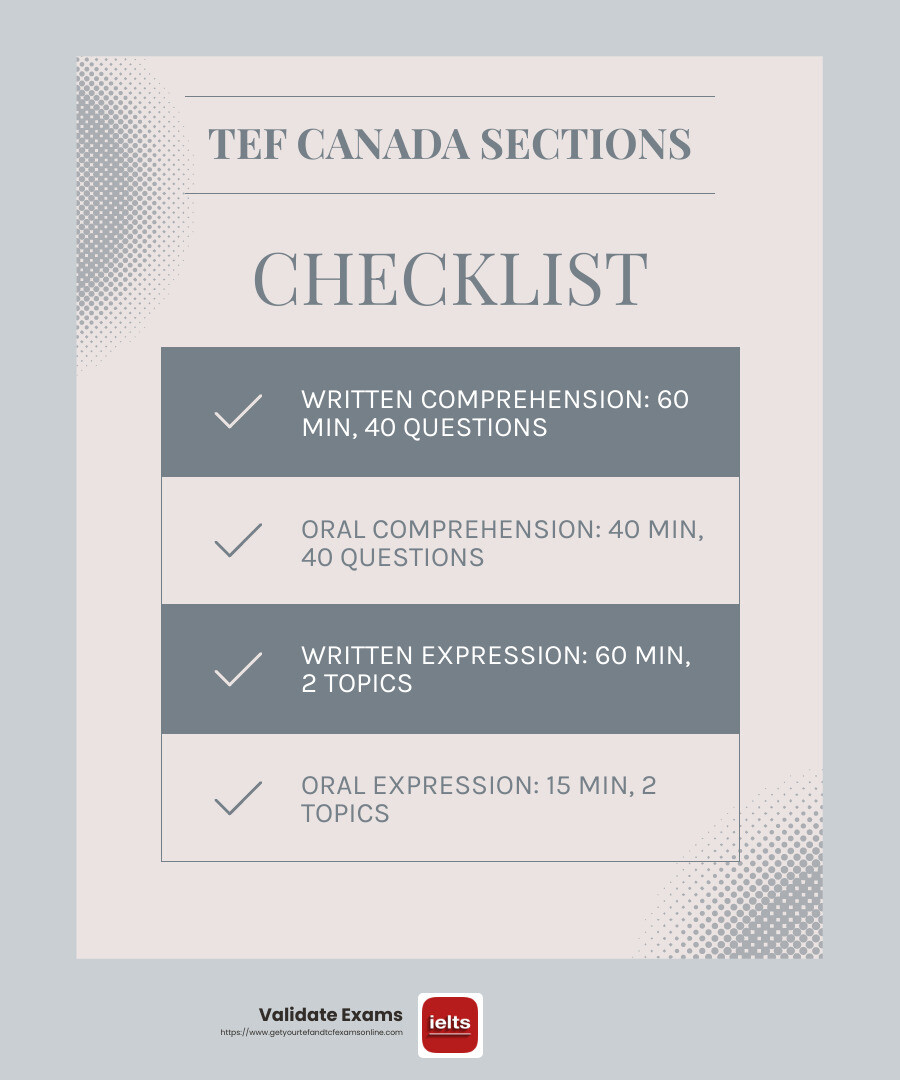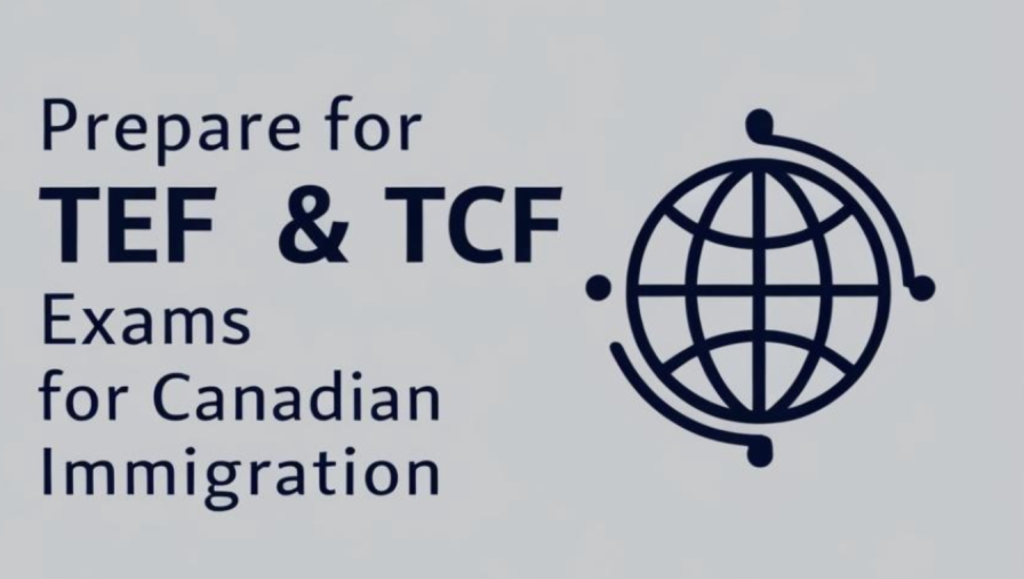TEF Canada Format: Top 6 Tips for Stress-Free Success
TEF Canada format is crucial to understand if you’re planning to use French language skills for immigration or academic purposes in Canada. This exam assesses proficiency across four key language skills: Listening, Reading, Speaking, and Writing.
- Listening: 40 questions, 40 minutes
- Reading: 40 questions, 60 minutes
- Speaking: 2 tasks, 15 minutes
- Writing: 2 tasks, 60 minutes
TEF Canada is a stepping stone for many aspiring immigrants and students like Alex, who want to study or work in a French-speaking environment in Canada. It serves as a comprehensive test to gauge your French language abilities, ensuring you meet the necessary standards for communication in daily and professional settings.
I’m Baddo Magical, an expert in language proficiency exams such as the TEF Canada format. My experience spans across various proficiency tests, helping candidates like you understand and ace these exams. Let’s explore the structure and requirements in the next sections to prepare effectively for this crucial test.

Understanding the TEF Canada Format
When preparing for the TEF Canada format, it’s important to understand each component of the exam. This test evaluates your skills in four main areas: Listening, Reading, Speaking, and Writing. Each section is designed to assess different aspects of your French language proficiency.
Exam Components
- Listening (Compréhension Orale): This section measures your ability to understand spoken French. You’ll listen to conversations, news reports, and discussions. The test consists of 40 questions to be answered in 40 minutes. This part is crucial for evaluating how well you can follow spoken French in various contexts.
- Reading (Compréhension Écrite): Here, your ability to comprehend written French is tested. You’ll encounter a range of texts of varying complexity and answer 40 questions in 60 minutes. This section assesses how well you can extract information and understand written content.
- Speaking (Expression Orale): In this part, you will demonstrate your verbal communication skills. The speaking test involves two tasks over 15 minutes, which may include describing a picture, expressing opinions, and participating in a simulated conversation. This section is key for showing your ability to articulate thoughts in French.
- Writing (Expression Écrite): This section evaluates your written communication skills. You will complete two tasks within 60 minutes, such as summarizing information, expressing opinions, or writing formal letters or essays. It tests your ability to convey ideas clearly and effectively in written French.
Scoring
Each section of the TEF Canada exam is scored on a scale of 699 points. The scores reflect your proficiency level, which can range from beginner to advanced. Achieving a high score can significantly improve your prospects for immigration or academic opportunities in Canada.

Understanding these components is essential to tailor your preparation and ensure you are ready for each part of the test. This knowledge will help you identify areas where you might need more practice and focus your study efforts effectively.
Detailed Breakdown of Each Test Section
Let’s dive deeper into each section of the TEF Canada format. Understanding these details will help you better prepare for the exam and maximize your score.
Written Comprehension
Duration: 60 minutes
Questions: 40
Points: 699
In the Written Comprehension section, you’ll face a series of texts. These range from simple to complex. Your task is to read these passages and answer multiple-choice questions based on the content. This section evaluates your ability to understand written French and extract pertinent information.
Oral Comprehension
Duration: 40 minutes
Questions: 40
Points: 699
For Oral Comprehension, you’ll listen to various audio clips. These include conversations, news reports, and discussions. The goal is to answer questions that test your ability to follow and understand spoken French. This section is crucial for gauging how well you can interpret spoken language in different scenarios.
Written Expression
Duration: 60 minutes
Topics: 2
Points: 699
In Written Expression, you’re tasked with two writing assignments. These could involve summarizing information, expressing opinions, or crafting formal letters or essays. This section tests your ability to clearly and effectively communicate ideas in written French. Your writing will be evaluated on clarity, structure, and grammatical accuracy.
Oral Expression
Duration: 15 minutes
Topics: 2
Points: 699
The Oral Expression section assesses your spoken French skills. You will engage in two tasks, such as describing a picture or expressing your opinion on a given topic. This part of the exam may also include a simulated conversation with the examiner. Your performance will be scored based on fluency, vocabulary, and pronunciation.

Understanding these sections in detail can help you focus your preparation efforts. Knowing what to expect in each part of the exam allows you to practice effectively and improve your proficiency in the French language.
Preparing for the TEF Canada Exam
Preparing for the TEF Canada format exam can feel overwhelming, but with the right resources and strategies, you can boost your confidence and performance. Here are some key tips and resources to help you succeed.
Study Resources
- Official Guides and Textbooks: Start with materials specifically designed for the TEF Canada exam. These often include practice questions and detailed explanations. Look for resources that are well-reviewed and recommended by reputable language learning institutions.
- Online Courses: Consider enrolling in online courses that offer assessments to help you evaluate your current French level. Depending on your proficiency, you can choose courses custom to your needs, whether beginner, intermediate, or advanced.
- Language Apps: Apps like Duolingo or Babbel can supplement your studies. They provide interactive exercises to improve your vocabulary and grammar skills.
Preparation Tips
- Regular Practice: Dedicate a set amount of time each day to practice. Consistency is key to improving language skills.
- Simulate Test Conditions: Practice under timed conditions to get used to the pace of the exam. This will help you manage your time effectively during the actual test.
- Focus on Weak Areas: Identify which sections you find most challenging and spend extra time improving those skills. Use practice tests to pinpoint these areas.
- Immerse Yourself in French: Surround yourself with the language as much as possible. Watch French movies, listen to French podcasts, and try conversing with native speakers.
Practice Tests
Taking practice tests is one of the most effective ways to prepare for the TEF Canada format. They help you get familiar with the types of questions you’ll encounter and the exam’s structure.
- Mock Tests: Enroll in courses that offer mock exams. These simulate the real test environment, helping you gauge your readiness.
- Feedback and Review: After each practice test, review your answers. Understand why you got certain questions wrong and learn from your mistakes.
By using these study resources, following these preparation tips, and regularly taking practice tests, you’ll be well-prepared to tackle the TEF Canada exam. The key is to practice consistently and focus on improving your weaknesses.
Next, let’s explore what you can expect on the actual test day to ensure a smooth and stress-free experience.
What to Expect on Test Day
Test day is finally here, and knowing what to expect can help ease those nerves. Here’s a simple breakdown of the TEF Canada format exam day procedures, identification requirements, and test center rules.
Exam Procedures
Arrival Time: Arrive at your test center well ahead of the scheduled time. This gives you some buffer time for unexpected delays and allows you to settle in.
Registration Process: Once you arrive, you’ll need to check in. The staff will guide you through the registration process, ensuring you are on the list and have all necessary documents.
Test Sequence: The TEF Canada exam typically starts with the listening and reading sections, followed by writing and speaking. The order might vary slightly depending on the center, so listen carefully to the instructions.
Identification Requirements
Valid ID: You must bring a valid form of identification, like a passport or national ID. Ensure the name on your ID matches the name you used during registration. This is crucial for verifying your identity.
Photo ID: Some centers might require a recent passport-sized photograph. It’s a good idea to have one ready just in case.
Test Center Rules
Electronic Devices: Leave all electronic devices, including phones, smartwatches, and tablets, outside the exam room. These are not allowed during the test to maintain integrity.
Personal Belongings: You might be asked to store your personal items in a designated area. Only bring what’s necessary to the test center.
Silence: Maintain silence in the exam room. Any form of communication with other test-takers is strictly prohibited and could lead to disqualification.
Breaks: Follow the instructions regarding breaks. Typically, there are short breaks between sections, but these are timed, so be mindful of the schedule.
Being well-prepared and knowing what to expect on test day can make a big difference. By following these guidelines, you can ensure a smooth and stress-free experience, allowing you to focus entirely on demonstrating your French proficiency.
Next, we’ll tackle some frequently asked questions to further clarify the TEF Canada format.
Frequently Asked Questions about TEF Canada Format
What is the duration of the TEF Canada exam?
The TEF Canada format exam spans several hours, as it includes multiple sections. Here’s a quick breakdown:
- Written Comprehension: 60 minutes
- Oral Comprehension: 40 minutes
- Written Expression: 60 minutes
- Oral Expression: 15 minutes
In total, you’ll spend about 3 hours actively testing. However, including registration, breaks, and any delays, plan for a longer day.
How are the TEF Canada results delivered?
After taking the exam, patience is key. TEF Canada results are usually sent out within 4-6 weeks. You’ll receive a certificate detailing your scores and proficiency levels. These results can be delivered via mail or email, depending on your test center’s policy.
Can I retake the TEF Canada exam?
Absolutely! You can retake the exam if needed. However, there’s a mandatory waiting period of at least 2 months between attempts. This gives you time to focus on areas that need improvement before your next try.
Conclusion
Navigating the TEF Canada format can be daunting, but it doesn’t have to be. At Validate Exams, we understand the stress that comes with traditional testing methods. Our mission is to provide a stress-free certification process that guarantees results.
With us, there’s no need to worry about the complexities of exam preparation or the anxiety of test day. We offer genuine and verifiable language proficiency certificates, allowing you to bypass the traditional exam process. Our unique service ensures you get the scores you need, quickly and efficiently.
Whether you’re looking to immigrate to Canada, pursue academic opportunities, or advance your career, achieving the right certification can open many doors. Let us handle the complexities, so you can focus on your future.
Find how we can help you achieve your goals with our TEF Exam services. With Validate Exams, your path to success is just a click away.

